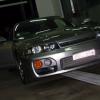Boost Response Help!
Announcements
-
Similar Content
-
Latest Posts
-
By Dose Pipe Sutututu · Posted
But but but.... You have a NEO Cam sprocket Sure am ☺️ -
Thanks brother, are you NHB ? RB25 s1 my man hahahah 💀
-
New tyres bleed the brakes sort out lights and historic registration time for the sub r31 IMG_0551.mov
-
Had a chat to Tony Mamo - he advised that looking at the graph's shape (regardless of number translation) it shouldn't be levelling off like that up top. He said it looks like the car is running a restrictor plate or something of that nature. Luckily the last dyno pull on E85 was saved to the PC - So I did a quick trace of Barometric KPA vs Intake manifold pressure, and lo and behold I see a copy of the 'waves' I was seeing on the dyno: I'm not entirely sure how to go about addressing this. It may be worth sacrificing IAT to run a more direct intake for the motor. Though packaging this could be flat out impossible given the constraints of the car. I should have removed the intake pipe to see if this made a difference but looking at this graph I now have something to potentially test in the future and think about. This one is from an old track day log in the OLD setup going through gears on track.
-







Recommended Posts
Create an account or sign in to comment
You need to be a member in order to leave a comment
Create an account
Sign up for a new account in our community. It's easy!
Register a new accountSign in
Already have an account? Sign in here.
Sign In Now